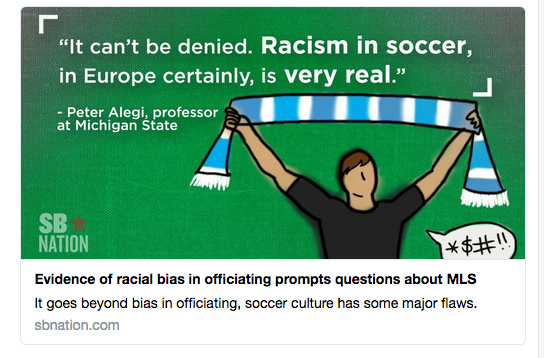
Is there an implicit racial bias in Major League Soccer and other U.S. leagues?
A piercing SB Nation story this week grappled with the implications of a recent study‘s disturbing findings “that black players are 14 percent more likely to be called for cautions than their non-black counterparts.” The study by Paste magazine also found that “black players are [. . .] more than twice as likely to receive red card ejections.”
In the article, I share my thoughts on this important issue with the SB Nation reporter, Tyler Tynes. I point out that “while finding empirical data is difficult, there’s plenty of soft and hard discrimination to believe that bias can take hold in refereeing. American soccer is not excused.” In fact, officiating bias can be understood as part of a broader pattern of racism in soccer, in the U.S. and internationally, one characterized by the practice of “stacking,” the presence of very few black coaches on the sidelines, and multiple forms of racist fan behavior.
“It can’t be denied,” I say in the piece. “Racism in soccer, in Europe certainly, is very real. And, regrettably, despite all the progress that’s been made in terms of messaging and tolerance in local football culture, it’s still there. And everybody knows it.”
But don’t take my word for it, click here to read the full story.
Tag: race
Afritalians: Past is Prologue
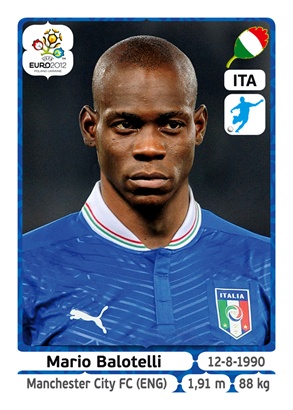 The Africanization of Italy may have started 2200 years ago as Hannibal of Carthage led his troops and elephants across the Alps on the way to Rome, but Mario Balotelli’s two-goal performance in Italy’s defeat of Germany in the Euro 2012 semifinal may be mainstreaming it.
The Africanization of Italy may have started 2200 years ago as Hannibal of Carthage led his troops and elephants across the Alps on the way to Rome, but Mario Balotelli’s two-goal performance in Italy’s defeat of Germany in the Euro 2012 semifinal may be mainstreaming it.
Italians across the political spectrum are gushing in their praise of the 21-year-old striker. “Pride of Italy!” screamed the web site of La Gazzetta dello Sport, which earlier in the week had printed an insulting cartoon of Balotelli as King Kong by Valerio Marini (see below). (Despite an outpouring of criticism from readers and on social media, the paper could only muster this sad excuse for an apology: “if certain readers found the cartoon offensive, we apologize.”) 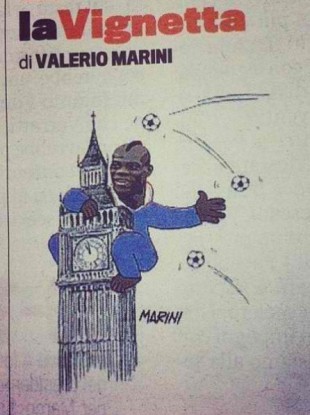
Earlier in the tournament Balotelli had won accolades for his acrobatic overhead strike against Ireland and for his impeccable penalty which opened the shootout against England (scored against Man City teammate Joe Hart). Now, on the eve of the final against Spain in Kiev, ordinary Italians and the media are comparing Balotelli to Gigi Riva, Totò Schillaci, and Gianluca Vialli — illustrious Azzurri of the past who transcended the football pitch to become popular icons of national culture. A big and very noticeable difference between Super-Mario and his predecessors, of course, is that Balotelli is black — the Palermo-born son of the Barwuahs from Ghana who was adopted by the Balotellis of Brescia. He is the first Afritalian football superstar.
Super-Mario’s central role in potentially ushering in a new phase in the Africanization of Italy is reflected in Italian media stories highlighting how Mario is like you and me: he loves football, family, pizza, and hanging out with his friends. In a country where mothers are sacred and where the Virgin Mary is venerated almost as much as her more famous son, Mario’s loving embrace of Mamma Silvia in the stands at the Warsaw stadium shot an arrow into the heart of every Italian. “Boastful and ‘mammone’, Balotelli represents the prototype of the Italian,” wrote Il Giornale, a conservative paper owned by Silvio Berlusconi’s brother, Paolo.
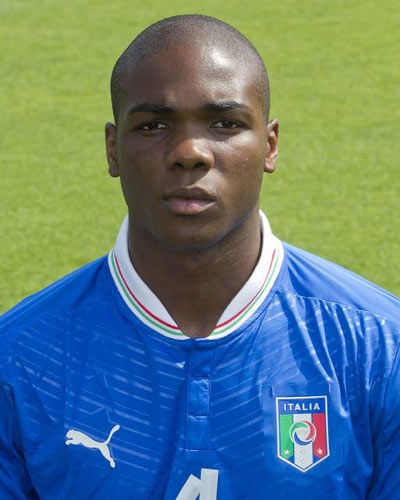 And Balotelli is not an isolated case; he’s not even the only Afritalian in the Euro squad. Sitting on the reserves’ bench is 24-year-old Angelo Obinze Ogbonna (at left), a central defender who plays his club football for Torino. Born in Cassino, near Rome, of Nigerian parents, Ogbonna was recruited into the Torino youth academy at age 14 and played his first serie A match at 19. Like Balotelli, Ogbonna speaks Italian without a trace of accent. The experiences of Super-Mario and Ogbonna open up an opportunity to consider the history of Afritalian footballers.
And Balotelli is not an isolated case; he’s not even the only Afritalian in the Euro squad. Sitting on the reserves’ bench is 24-year-old Angelo Obinze Ogbonna (at left), a central defender who plays his club football for Torino. Born in Cassino, near Rome, of Nigerian parents, Ogbonna was recruited into the Torino youth academy at age 14 and played his first serie A match at 19. Like Balotelli, Ogbonna speaks Italian without a trace of accent. The experiences of Super-Mario and Ogbonna open up an opportunity to consider the history of Afritalian footballers.
Let’s start with Claudio Gentile. He was born in Tripoli, the son of a Sicilian father and a Tripoli-born mother possibly of Italian background, and grew up playing street football in Libya before moving to Como in 1961 with his family. Nicknamed “il libico,” Gentile had his best years at right back for Juventus and Italy in the 1970s and early 1980s, forming with Dino Zoff, Antonio Cabrini, and Gaetano Scirea one of the stingiest defensive lines of all time. Gentile’s ferociously effective man-to-man marking of Maradona and Zico in the 1982 World Cup, which Italy won, has become the stuff of legend.
We had to wait nearly two decades for the next Afritalians to make an appearance in the national team. In 2001, Fabio Liverani, the Rome-born son of a Somali mother and Italian father, made his international debut in a friendly against South Africa. Despite a solid career as a midfielder with Lazio, Fiorentina, and Palermo, Liverani only played twice more for the Azzurri. Around the same time, Matteo Ferrari, the Algeria-born son of an Italian father and a Guinean mother, played eleven times in the heart of Italy’s defense. Prior to Balotelli’s success, Ferrari had held the record for most international appearances for an Afritalian. (He now plays for the Montreal Impact in MLS.)
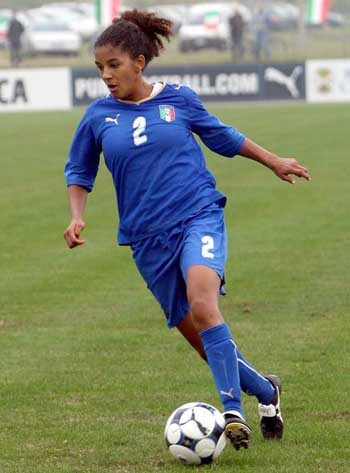 There are other players of African blood in Italian football. Among them, Stephan El Shaarawi, Stefano Chuka Okaka, and Fabiano Santacroce (of Afro-Brazilian/Italian parentage) have been capped at junior level. There is also a female Afritalian: left back Sara Gama (at right), who also earned the distinction of becoming the first Afritalian woman to captain the U-19 national team, and leading them to the 2008 European title.
There are other players of African blood in Italian football. Among them, Stephan El Shaarawi, Stefano Chuka Okaka, and Fabiano Santacroce (of Afro-Brazilian/Italian parentage) have been capped at junior level. There is also a female Afritalian: left back Sara Gama (at right), who also earned the distinction of becoming the first Afritalian woman to captain the U-19 national team, and leading them to the 2008 European title.
Mauro Valeri, a sociologist and author of La Razza in campo: Per una storia della Rivoluzione Nera nel calcio (EDUP, 2005) wonders if the increasing presence of black players at junior and senior level is “perhaps a sign of a transformation underway, of the affirmation of a Black Revolution [in football] that for more than a decade has been unfolding in Italy.” While structural changes would be necessary for such a shift to be lasting and meaningful, social perceptions of Afritalians may be changing thanks to Balotelli’s sudden popularity. In a grim age of austerity and structural adjustment, Italians seem eager for another taste of Super-Mario-triggered football euphoria.
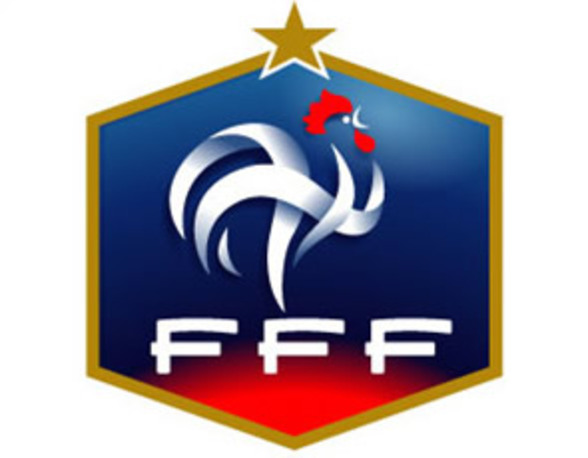
An investigative report by the Mediapart website revealed that numerous managers of the National Technical Directorate (DTN) and the French Football Federation (FFF) approved the “principle of discriminatory quotas” in November 2010. Their objective? To limit the number of players of West African and North African origin.
According to Mediapart, Laurent Blanc — manager of Les Bleus — would have played an active role in those discussions. It is alleged that Blanc highlighted the problem of players who spend three years in training in France and later go abroad to wear other teams’ jerseys. “Something like that cannot not create problems, it applies to the Latin Americans as well,” said Philippe Tournon, press officer of the national team.
At the heart of the problem, the report claims, is growing dissatisfaction among French managers, coaches, and administrators about players who are trained in France, develop into potential national team stars, and who then instead choose — for whatever reason — to represent another country thanks to their double citizenship. “The fact is, there is a large presence of bi-national players at the junior level,” said Fernand Duchaussoy, FFF President, “and some of them later do not want to be part of the national French team.” FIFA rules allow a player with double citizenship to play for a junior national team in one country and still go on to play for another country’s senior national team.
In response to the uproar that followed these revelations, Sports Minister Chantal Jouanno suspended FFF technical director Francois Blaquart, the author of a “quota chart” published on Thursday (May 5) by Mediapart. The explosive issue of racial quotas in French football is embedded in wider debates about immigration, race, and national identity in contemporary France. As Laurent Dubois puts it in Soccer Empire: The World Cup and the Future of France, “When a team takes to the field, the fans say, ‘They are us, and we are them.’ But sometimes that can also force a question: ‘Who are they? And who are we?'”
Race, Class and SA Football
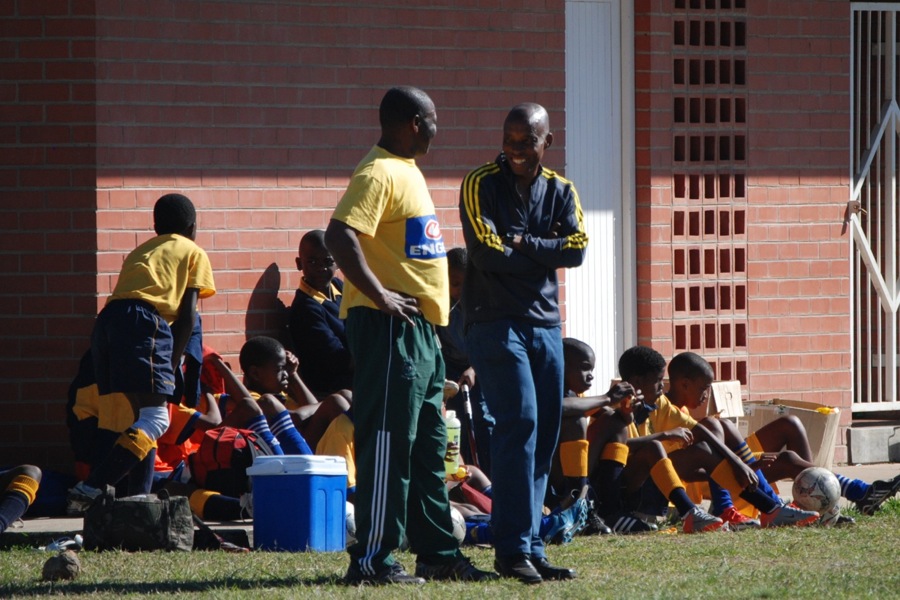
‘Talking Football’ by Thabo Dladla (Echo, 5 August 2010)
The euphoria and excitement that grew around football during the recent World Cup are not likely to boost the beautiful game in South Africa. If our attitudes do not change towards this predominantly black sport, it will remain a stepchild of South African sport for many years to come.
Rugby and cricket will continue to receive support from businesses and decision makers. The black elites’ children attend private and formerly white high schools which promote rugby and cricket . . . [codes] which enjoy the best sporting facilities, all the way up to university level. The few facilities available to football are either poorly maintained or not maintained at all.
The system continues to support the rich and politically powerful. there are many black faces leading institutions such as schools, universities, municipalities and government departments, and yet football continues to struggle.
At university level rugby enjoys huge sponsorship and coverage on television while football [does] not despite the huge number of students who play the game . . . The young men and women in this age group should be competing in U20 and U23 competitions. The Izichwe Youth programme based at the University of KwaZulu-Natal strives to address some of the challenges faced by the needy youth.[The program receives support from Ilawu B.B., National Lottery, Metropolitan, Adidas and Viking Stavanger FC in Norway.]
The rich and powerful call for more police and prisons. Yet the country requires youth programmes to empower our youngsters socially, economically and academically, to shape their future. I would like to see a change in attitude from those who make decisions in government and business.
It is not only the rugby-playing children from middle class families who have dreams. Patriotism is not only about carrying flags and singing national anthems, it is more about caring and supporting your fellow citizens.
[Click to listen to podcast with Thabo Dladla and fellow coaches.]
Fruity Finals
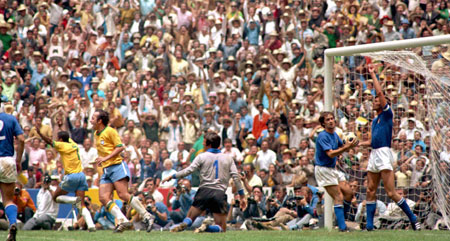
[Charged with breaking down the European qualifiers, David Patrick Lane takes a moment to tell us what he really thinks. Next Group 7. Serbia, France, and yes, our Austrian friends will soon make an appearance.]
The 1970 World Cup was a watershed moment for the modern game, if for no other reason than it was broadcast in color. Color TV sets were a newfangled invention then, though many folks have continued to watch World Cups as if they were taking place in snowstorms.
There have been 10 World Cups since 1970. That’s 40 different semi finalists. Yet only four have come from outside Europe.